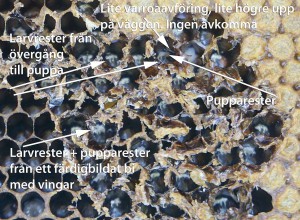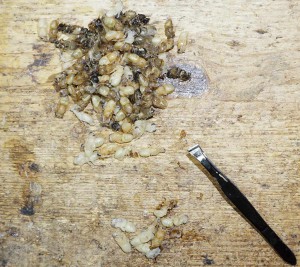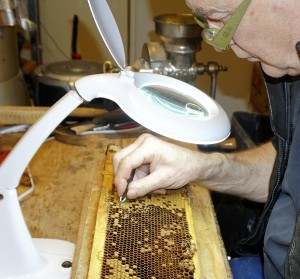I have done some VSH-tests by now and maybe my experiences can inspire some of you. I have made a checklist that maybe can be of some help.
What I use
I use a reading lens with a ringlamp with about 2.5 times magnification. I also use a couple of reading glasses with the same magnification to get about 6 times. But you can try what combination works the best for you.
Place the comb under the reading glass about 10-20 cm (4-8”) from it. You work out the best distance, also where to place your eyes above it.
As you drag out the pupae you may have to move the comb somewhat for best sight into the cells. Also you can tilt the comb back and forth a little for the same reason.
Use a pair of tweezers of your like. I use one with a slanted tip. You get a grip on the pupa a little better, but on the other hand it can be easier to torn it into pieces.
Three piles of pupae
- Pupae without mites go to one pile. It will be the biggest. When you have 10 in it you push it up a bit and away somewhat. I do the same with the next 10 and keep it separate from the first 10. This way it’s easier for me to count them. When I have got 5 piles like that I push them together. Then I go on with the next 10-pile. When I’ve got 100 pupae without mites my patience is over. Sometimes, to be sure about the result you may have to pull more pupae, especially if you have treated the colony effectively the previous season.
- Pupae with mites that have no offspring go to pile 2. Some pupae will have just one male or one female. Those will not be reproductive and I put those in pile 2 as well.
- A pupa that has a mite with at least one male and one female offspring goes to pile 3. The male is white and somewhat smaller. The form is not as even roundish like a crab as the females look like.
What I look for
- The eyes of the pupa of the bee should have at least a dark purple color, not a light pink. The rest of the pupa may be white, but it will darken with time. This is to give the mother mite enough time to reproduce, if it will. The pupa may also have transformed fully into a bee with a dark moving head, and wings. If this is the case when you pull it, expect the bottom to look a little different.
- The first to look at is the bottom of the cell when the pupa is pulled. If it’s not a fully transformed be that is pulled but a pupa, and there is no mite in the cell you will just see a whitish thread-like tangles on one side of the bottom, often the upper side. If you just see that and nothing else, you don’t have to look more. There is no mite in that cell. (Well, when you get a little more experienced, I’m not yet, you may have once in a while see a trapped mite upside down at the bottom under the cocoon.)
- If it is a fully transformed bee you pull, then you will find the threadlike tangles. But also a more compact whitish lump, most often in contact with the tangles. The tangles is the rest of the larva-skin, the lump the rest of the pupa-skin, both from the different transformations to the fully transformed bee.
- If the there is a mite in the cell you will also see a still whiter compact lump of feces of the mite, often somewhat prolonged. Especially you can see the prolonged form when there’s just somewhat feces. Most often also the feces is a little higher up on the cell wall. It’s resembling the pupa-skin more than the larva-skin. The easiest way to avoid confusion and wrongly take the feces for pupa-skin or the other way round is to avoid pulling fully transformed bees.
 The light made the tangles, the larva skin look more compact. In some cells you also find the more compact pupa skin. In only one cell there was this small piece of prolonged very white varroa feces. And yes, in this cell there was a mite, and a mite with no offspring. The only one I found in this colony. Of course it’s interesting for breeding even if there is no statistical significance for the very highVSH value, due to the low number of mites.
The light made the tangles, the larva skin look more compact. In some cells you also find the more compact pupa skin. In only one cell there was this small piece of prolonged very white varroa feces. And yes, in this cell there was a mite, and a mite with no offspring. The only one I found in this colony. Of course it’s interesting for breeding even if there is no statistical significance for the very highVSH value, due to the low number of mites.
The feces of the Varroa
Sometimes it’s only a small somewhat prolonged stain of feces. Most often then the mite has no offspring, or possibly a non-reproductive offspring. Maybe the mite hasn’t been able to eat enough nourishing food, or it’s too old, who knows.
If it’s a lot of white on the cell bottom and the cell wall, you find a lot of feces and quite some offspring. Also nymph skins from the young mites. Then you will most probably find a whole Varroa family, one male and several females, white and light brown, as well as the dark brown mother mite. In such a big family, the mites are vital and run around on the bottom and cell wall. Sometimes there’s more than one mother mite in one cell.
In a cell with a lone mother mite without offspring or with a single offspring they most often just move slowly. Maybe the mother mite is old and stiff and have bad food.:)
A good film showing the development stages of the bee and of the mites can be seen here: https://www.youtube.com/watch?v=a2vg59Snt6c
 In the big pile there is 100 pupae and fully transformed bees.
In the big pile there is 100 pupae and fully transformed bees.
Calculation
Add the number of pupae in piles 2 and 3. Let’s say there are 3 pupae in pile 2 and 7 in pile 3. Then you get 3+7=10 pupae in total with mites. 3/10=30%, which is the VSH-value. Just about enough to be able to use in breeding better VSH.
If you have 100 pupae in pile 1 you have pulled in total 100+3+7=110 pupae the degree of infection in the brood is 10/110=0.09=9%. It’s difficult to compare this with the degree of infection on the bees, the amount of phoretic mites, which you get with for example an alcohol wash. Maybe it’s half this value, maybe it’s more, maybe less.
If you have done an effective treatment the previous season you may have to pull at least 200 pupae. Maybe you have to wait to late summer to make the VSH test.
